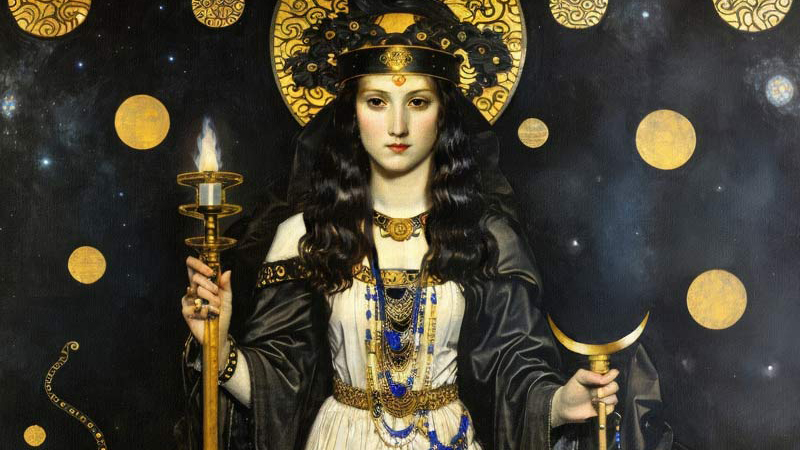At a crossroads: the myth of Hekate and the dangers of psychic dependence. When many people today hear the name HecateThey think about witchcraft or the occult. However, the figure of Hecate is much older and more complex than these modern associations suggest. His history spans thousands of years, evolving from a figure of light and guidance to one of darkness and fear. Exploring this transformation helps us understand how cultural symbols change and why we should be careful not to give too much weight to certain myths in our spiritual lives.
ancient origins
Some scholars attribute Hecate’s origins to early Mediterranean or Egyptian influences. The Egyptian goddess Heket and the concept of heka—which means “magical speech”—may have shaped his identity. Hecate later became linked to thresholds, crossroads, and liminal spaces, places of both potential and danger.
The ancient Greeks honored her as a powerful yet mysterious figure. In early myths, Zeus was said to bless her and to bring favor and prosperity. She carried torches that illuminated the path in the darkness and was considered a guardian of travelers and the lost. At this stage, Hecate represented wisdom and transition: the light that guides through uncertainty.
From light bearer to shadow figure
As the centuries passed, Hecate’s image became darker. Artists and poets began to portray her as a goddess of ghosts, witchcraft and the underworld. Her “triple form,” often depicted with three faces or bodies, was said to represent the past, present, and future, or the phases of womanhood: maiden, mother, and crone. However, as attention focused on her elderly appearance, the nourishing and life-giving aspects of her myth faded.
In later depictions, Hecate often appeared accompanied by black dogs, creatures long associated with death and the underworld. His presence at the crossroads, once a symbol of life’s choices, came to represent the dangers of spiritual confusion and the temptation to seek hidden knowledge away from God.
We sometimes call depression the “black dog,” the weight of fear that can take hold of us when we face uncertainty. Hecate’s other ancient symbol, the cross of crossroads, reminds us how easily we can get caught between paths: we long for guidance, but we look to the wrong sources to find it.
When people are unsure which direction to take, they may be tempted to turn to oracles, fortune tellers, or other means of divination. But such practices only deepen the feeling of being lost. Like those caught between worlds in the myth of Hecate, we can become trapped in a spiritual limbo: hesitant to move forward, afraid to trust God and ourselves with the next step.
Lessons from the myth
The story of Hecate can be read as a reflection of humanity’s fascination with power, mystery and control over destiny. The same impulse that led the ancients to pray to him for guidance at life’s crossroads still tempts people today: to seek knowledge or direction through questionable sources.
The Christian Scriptures warn that the desire to know “hidden things” or to manipulate spiritual forces apart from God leads only to darkness (Deuteronomy 18:10-12). The myth of Hekate shows what happens when a culture’s symbols of wisdom and guidance become intertwined with fear, secrecy, and the illusion of self-created power.
Finding the true light at the crossroads
The crossroads, a central symbol in the myth of Hecate, can remind us of something deeper when seen through the lens of esoteric Christianity. Life often takes us to places where we must choose a path: between light and darkness, humility and pride, trust in God and trust in ourselves.
Where Hecate is a torchbearer, we also recognize Christ as the true light of the world (John 8:12), who can also guide us in uncertainty, but without the risk of deception or danger. Hecate’s story, then, becomes not an invitation to invoke her spirit but a reminder of humanity’s longing for guidance. This longing can be satisfied through connection with the inner gnosis and our supreme creator, rather than through cryptic communications from the lower realms.
A word of caution
While it may be historically and culturally interesting to study mythological figures like Hecate, it is important not to romanticize or internalize them as personal “archetypes.” When people identify too much with these symbols, they run the risk of giving them spiritual authority in their lives. What begins as fascination can turn into fixation. Seeking guidance from psychics can quickly become addictive, opening the door to spiritual deception and oppression by negative entities.
Instead, we are called to seek truth, clarity, and protection through intuition and our connection with the Holy Spirit. Myths like Hekate’s may serve as reminders of humanity’s spiritual hunger, but they cannot satisfy it.
In summary: The myth of Hecate reveals both humanity’s creativity and its spiritual vulnerability. It was once a symbol of light, but came to be associated with darkness and confusion, a pattern that reflects what happens when people turn away from the Light. His story is a sober reflection on the need for discernment when seeking spiritual guidance.



